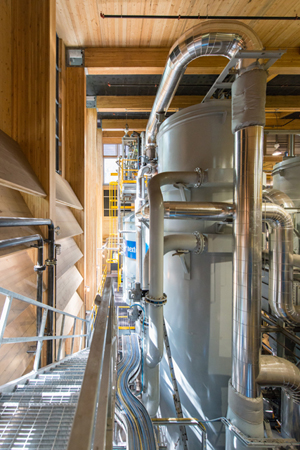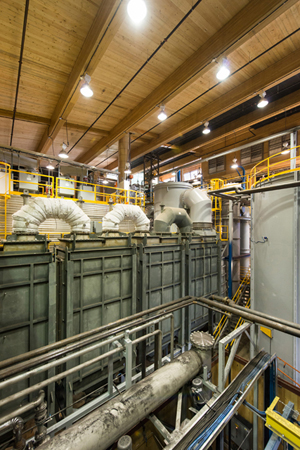A Living Laboratory: Combining technologies for bioenergy success
 Many buzzwords have dominated headlines over the past few years—from energy security and peak oil to climate change, recession, and even fracking, to name a few.
Many buzzwords have dominated headlines over the past few years—from energy security and peak oil to climate change, recession, and even fracking, to name a few.
Less than a decade ago, the North American economy was buoyant, energy costs were skyrocketing, climate change dominated headlines, and there was a growing demand for renewable energy. No one could have predicted the energy revolution that would create a glut of low-priced natural gas, unleashed by hydraulic fracturing. This has spurred a massive adoption of natural gas for power generation, transportation, and plans for export.
The effect of those low prices on many renewable energy technologies like solar, wind, biomass heat, and power generation has been devastating.
Commercializing renewable energy technologies has always had its challenges, competing with incumbent fossil fuel technologies in a risk adverse economic climate being chief among them. But, the double whammy of bargain basement natural gas prices and a prolonged world recession have sent countless clean technology companies into the graveyard of great ideas.
Bioenergy in action
Standing in defiance of all these negative trends is a gleaming new glass, metal, and wood bioenergy facility at the University of British Columbia (UBC) in Vancouver, Canada. The plant is North America’s first commercial demonstration of a transformative system that combines biomass gasification and syngas conditioning technologies with a highly efficient internal combustion engine.
The commercial-scale, proprietary gasification system, converts local, renewable waste feedstocks (such as wood waste) into clean burning “syngas” that can be used as a substitute for natural gas and other fossil fuels in a range of applications. Coupled with the new syngas thermal cracking technology, the gasification systems allows a gas stream to be directly fired into a high-efficient gas engine. The advantage of this approach is that it produces electricity 25% more efficiently than conventional steam-based electricity, with less water consumption, while still meeting the stringent air-quality standards of urban communities.
“This facility targets a major challenge facing society—the need for new, clean energy solutions that work at a community scale,” says UBC President Stephen Toope. “This is a flagship example of UBC as a living laboratory, where researchers, staff, students, and partners collaborate on innovations targeting the pressing challenges of our day.”
The new system on the university’s campus operates in two modes: thermal and combined heat and power. The plant produces two megawatts (MW) of clean, renewable electricity—enough to power 1,500 homes—as well as three megawatts of thermal energy to heat the campus. By displacing natural gas, this reduces greenhouse gas emissions by 5,000 tonnes per year, which is equivalent to taking 1,000 cars off the road.
Overcoming the market
 The new UBC plant has generated considerable interest, drawing about 1,000 visitors from around the world within a few weeks of the grand opening. Similar projects have been completed at the US Department of Energy’s Oak Ridge National Laboratory in Tennessee and the University of Northern British Columbia in Prince George, as well as at Canadian companies Tolko Industries plywood mill, Kruger Products paper mill, and Dockside Green sustainable-living community in Victoria, BC.
The new UBC plant has generated considerable interest, drawing about 1,000 visitors from around the world within a few weeks of the grand opening. Similar projects have been completed at the US Department of Energy’s Oak Ridge National Laboratory in Tennessee and the University of Northern British Columbia in Prince George, as well as at Canadian companies Tolko Industries plywood mill, Kruger Products paper mill, and Dockside Green sustainable-living community in Victoria, BC.
Despite these successes, however, the market is not without its challenges, particularly around natural gas prices. When natural gas was $8 to $10 per one million British thermal units (MMBtu), for instance, there was a good business case for companies to shift from natural gas by investing in a large-scale gasifier that converted woody feedstock to clean fuel.
Advancing this technology became a priority over the past four years as natural gas “hub” prices plummeted to $2 MMBtu from $10 MMBtu. With such low prices, energy-from-waste systems became much less competitive in North America.
New technology
Although the plant at UBC is a story of success, more still needs to be done to overcome the cost of natural gas if renewables are, ultimately, to gain continued momentum and their full market share. One option is to test different and lower costing feedstocks.
A promising new feedstock is biosolids or sewage sludge from wastewater plants. Although the wastewater industry is traditionally conservative and highly risk adverse, it’s predicted that sludge—which usually ends up in landfills or used as fertilizer—will prove itself a viable feedstock. There are current plans for a demonstration plant within a year.
The dependence upon fossil fuels in North America and the growing markets of Asia will only increase the greenhouse gases being emitted into the atmosphere by coal, oil, and natural gas use if technology doesn’t continue to test and improve renewable options. Many countries, including the UK, Japan, Korea, and Brazil, have high fossil fuels prices, abundant waste feedstocks, and have government renewable energy incentives in place. Like Canada and the United States, they are looking for efficient, waste-to-energy systems.
With a plant such as the biomass gasification and syngas conditioning technologies one at the University of British Columbia, it’s exciting to see what the future will bring.
Nexterra Systems Corp. is a provider of plant-scale energy from renewable systems that generate energy and fuels.
~ Photos by Don Erhardt
Nexterra Systems Corp.
www.nexterra.ca
Author: Roberta Staley & Raymond McAllister
Volume: November/December 2012











